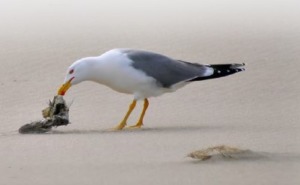Cet article vient d’être publié dans la revue Ecology and Evolution. [1]

On sait aujourd’hui qu’au-delà des populations humaines et des élevages on retrouve couramment des bactéries antibiorésistantes au sein des écosystèmes naturels, notamment dans l’eau et chez la faune sauvage. Les goélands présents en milieu urbain tels que les goélands leucophées font partie des espèces opportunistes proches de l’homme qui sont particulièrement fréquemment porteuses de ces bactéries. Dans cette nouvelle étude nous cherchons à comprendre les dynamiques spatiales et temporelles de portage de ces bactéries au sein d’une colonie entre l’éclosion et l’envol des poussins. Aucune structuration spatiale n’est identifiée. En revanche nous montrons que la proportion d’individus porteurs et la diversité des bactéries antibiorésistantes portées augmentent au cours de la saison. Ces résultats illustrent la complexité du portage d’antibiorésistances chez la faune sauvage et la nécessité de la prendre en compte pour mieux comprendre les dynamiques des antibiorésistances au sein des écosystèmes.
Vous pouvez le retrouver sur le portail documentaire de la Tour du Valat [2].
Résumé :
Wild animal species living in anthropogenic areas are commonly carriers of antimicrobial-resistant bacteria (AMRB), but their role in the epidemiology of these bacteria is unclear. Several studies on AMRB in wildlife have been cross-sectional in design and sampled individual animals at only one point in time. To further understand the role of wildlife in maintaining and potentially transmitting these bacteria to humans and livestock, longitudinal studies are needed in which samples are collected from individual animals over multiple time periods. In Europe, free-ranging yellow-legged gulls (Larus michahellis) commonly live in industrialized areas, forage in landfills, and have been found to carry AMRB in their feces. Using bacterial metagenomics and antimicrobial resistance characterization, we investigated the spatial and temporal patterns of AMRB in a nesting colony of yellow-legged gulls from an industrialized area in southern France. We collected 54 cloacal swabs from 31 yellow-legged gull chicks in 20 nests on three dates in 2016. We found that AMRB in chicks increased over time and was not spatially structured within the gull colony. This study highlights the complex occurrence of AMRB in a free-ranging wildlife species and contributes to our understanding of the public health risks and implications associated with ARMB-carrying gulls living in anthropogenic areas.
Référence bibliographique : Vittecoq M, Brazier L, Elguero E, Bravo IG, Renaud N, Manzano-Marín A, Prugnolle F, Godreuil S, Blanchon T, Roux F, Durand P, Renaud F, Thomas F. Multiresistant Enterobacteriaceae in yellow-legged gull chicks in their first weeks of life. Ecol Evol. 2022 Jun 11;12(6):e8974.